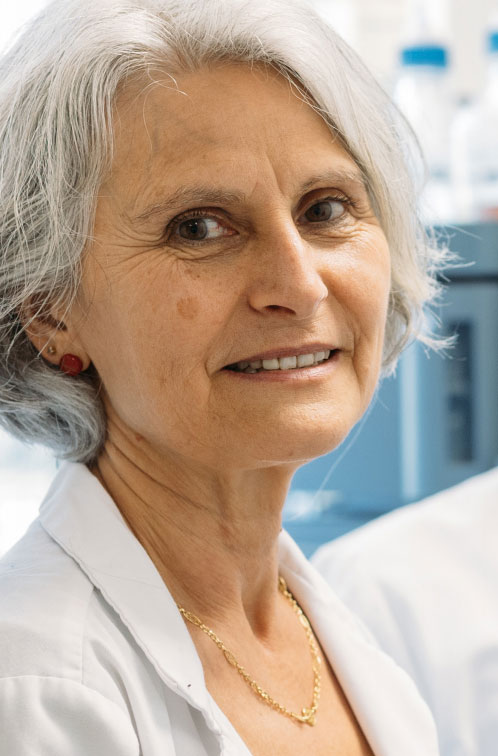
ConferenceSeries llc LTD invites all the participants from the world to attend the “33rd Experts Meet On Cancer Research & Therapy” which gathers all the people to share their knowledge and have a discussion on the current issue on cancer and development of cancer therapies.
33rd Experts Meet On Cancer Research & Therapy
Theme: Emerging & Innovative approaches for the advancement of cancer therapy
CANCER THERAPY MEETING 2022
ConferenceSeries llc LTD invites all the participants from the world to attend the “33rd Experts Meet On Cancer Research & Therapy” which gathers all the people to share their knowledge and have a discussion on the current issue on cancer and development of cancer therapies.
Who should attend?
Cancer Therapy Meeting 2022 is an expertise meet in the field of oncology where oncologists, scientists, researchers, medical students, pharmacists, R& D scholars, medical professors, gynecologists, molecular biologists, bioinformatics students and professors, radiologists, cancer research institutes to exchange ideas, communicate & discuss the research work and about new advancements in the cancer therapy and treatment.
Cancers that are diagnosed most in particular age groups;
- Leukemia for people aged 0-24
- Breast cancer for women and melanoma for men aged 25-49
- Prostate cancer for men and breast cancer for women aged 50-64
- Colorectal cancer for people aged 65 and above
Target audience
- Oncologists
- Radiologists
- Haematologists
- Gynaecologists
- Dermatologists
- Biotechnology students
- Bioinformatics students
- Research scholars in cancer
- R&D department in pharmacy
- Robotic science researchers
- Cancer research institutes
- Professors & Students from cancer research centers
- Cancer research universities in Asia-pacific regions
Why to attend?
With delegate scientists, renowned speakers from all over the world we are gathering people from all over the globe to have a spectacular conference. This is the best opportunity to reach the largest assemblage of participants from the different branches that are working on the cancer therapy to reduce the mortality rate by providing the highly effective therapy to the cancer patients.
Speakers will include world renowned experts in all disciplines, offering a unique opportunity to highlight new technologies in all aspects of cancer therapy.
Track: 1 Cancer Stem Cell Therapy:
Stem-cell therapy is the tradition of stem cells to treat or prevent a disease or condition. Stem Cells and Tumors cancer cells also have the distinguishing which is also associated with normal stems cells. Stem Cell Therapy is using to avert the disease. Stems cells relocate is used to treatment of cancer like leukemia, multiple Myeloma & lymphoma. Cord Blood Stem and Cancer cord blood encompasses hematopoietic (blood) stem cell. They consume long been used in stem cell treatments for leukemia, blood and bone marrow disorders when chemotherapy is used.
There are 2 main types of transplants. They are termed based on who gives the stem cells.
Autologous: The stem cells originate from the same person who will get the transplant.
Allogeneic: The stem cells derive from a matched related or unrelated donor.
Track: 2 Cancer Biomarkers:
A disease biomarker alludes to a substance or procedure that is characteristic of the nearness of malignancy in the body. A biomarker may be a molecule released by a tumor or a specific response of the body to the proximity of cancer. Genetic epigenetic, proteomic, glycomic and imaging biomarkers can be used for malignancy determination, forecast, and the study of disease transmission. In a perfect world, such biomarkers can be tested in non-obtrusively gathered biofluids like blood or serum. In disease research and drug, biomarkers are utilized in two essential ways:
- To help diagnose conditions, as in the case of identifying early stage cancers
- To figure how forceful a condition is, as on account of deciding a patient's capacity to admission without treatment
Track: 3 Cancer Gene Therapy:
Quality treatment is a malignant growth treatment that is still in the beginning times of research. Quality treatment is a kind of treatment which uses qualities to treat ailments. Scientists have been creating various sorts of quality treatment to treat malignant growth.
The thoughts for these new medicines have come about on the grounds that we are starting to see how disease cells are unique in relation to typical cells. It is still early days for this type of treatment. Some of these treatments are being looked at in clinical trials. Others can now be used for some people with types of cancer such as melanoma skin cancer.
Track: 4 Cancer Diagnosis :
Diagnostics assumes a key job all through every patient's malignant growth venture—previously, during and after treatment. During treatment, we track the size of the tumor, the infection's movement and your reaction to treatment, and adjust your treatment as required. In specific situations, insignificantly obtrusive apparatuses like navigational bronchoscopy and endoscopic ultrasound enable us to find and arrive at extremely little tumors without the requirement for medical procedure. After treatment, we help you avert, distinguish and deal with the reactions of the illness and its treatment, and we plan normal registration to screen for indications of metastasis or repeat.
Track: 5 Anti-Cancer drug discovery & therapy:
The most widely used treatments for cancer are surgery, radiotherapy and chemotherapy. Chemotherapy is the main choice for metastatic malignant growths, where the treatment must be foundational. The most often utilized chemotherapy medications have been distinguished experimentally with no previous information in regards to the sub-atomic instrument of activity of the medications. In spite of the noteworthy advancement accomplished in malignant growth care and research in the course of recent decades, the treatment alternatives for most of epithelial tumors have not changed a lot. In any case, a minimum amount of information has been collected that may change malignant growth medicines from cytotoxic regimens towards the quickly separating cells into customized focused on treatments. This section will give a review of as of now utilized chemotherapeutics and will investigate the effect of the atomic comprehension of malignancy on present day tranquilize disclosure, medicate improvement and disease treatment.
Track: 6 Radiation Therapy :
Radiation therapy uses waves of energy, such as light or heat, to treat cancers and other tumors and conditions. The form of radiation used in cancer therapy is a high-energy type known as ionizing radiation. Scientists still do not know exactly how radiation works as a treatment for cancer. They do know, however, that it breaks up the DNA of cancer cells in a way that disrupts their growth and division. In this way, radiation can kill cancer cells, preventing or slowing the spread of the disease. Sometimes a doctor prescribes radiation therapy alone, but usually, they recommend it in combination with other treatments, such as chemotherapy, surgery or both.
Track: 7 Cancer Immunotherapy :
Malignant growth immunotherapy is the fake incitement of the safe framework to treat malignant growth, enhancing the invulnerable framework's regular capacity to battle the malady. It is a use of the basic research of malignant growth immunology and a developing subspeciality of oncology. It abuses the way that malignancy cells frequently have tumor antigens, atoms on their surface that can be recognized by the immunizer proteins of the resistant framework, official to them. The tumor antigens are frequently proteins or different macromolecules. Typical antibodies tie to outside pathogens, however the altered immunotherapy antibodies tie to the tumor antigens stamping and recognizing the malignant growth cells for the safe framework to restrain or execute.
Track: 8 Breast Cancer:
Bosom malignant growth is disease that creates from bosom tissue. Signs of chest threat may fuse an inconsistency in the chest, a change alive and well, dimpling of the skin, fluid starting from the areola, an as of late modified areola, or a red or layered fix of skin. In those with inaccessible spread of the malady, there might be bone torment, swollen lymph hubs, brevity of breath, or yellow skin.
Bosom malignancy most ordinarily creates in cells from the coating of milk channels and the lobules that supply the pipes with milk. Malignant growths creating from the pipes are known as ductal carcinomas, while those creating from lobules are known as lobular carcinomas. The conclusion of bosom malignant growth is affirmed by taking a biopsy of the concerning lump. Once the determination is made, further tests are done to decide whether the disease has spread past the bosom and which medicines are well on the way to be powerful.
Track: 9 Lung Cancer:
Lung disease, otherwise called lung carcinoma, is a threatening lung tumor portrayed by uncontrolled cell development in tissues of the lung. This development can spread past the lung by the methodology of metastasis into near to tissue or various bits of the body. Most malignancies that start in the lung, known as essential lung diseases, are carcinomas. The two fundamental sorts are little cell lung carcinoma and non-little cell lung carcinoma. The most common symptoms are coughing, weight loss, shortness of breath, and chest pains.
Track: 10 Gastrointestinal Cancer :
Gastrointestinal illness implies perilous conditions of the gastrointestinal tract and decoration organs of preparing, including the throat, stomach, biliary structure, pancreas, little stomach related tract, interior organ, rectum and butt. The indications identify with the organ influenced and can incorporate hindrance, strange draining or other related issues. The conclusion regularly requires endoscopy, trailed by biopsy of suspicious tissue. The treatment relies upon the area of the tumor, just as the kind of malignant growth cell and whether it has attacked different tissues or spread somewhere else. These variables likewise decide the visualization.
Track: 11 Gynecologic Oncology:
Gynecologic oncology is a specific field of medication that spotlights on malignant growths of the female conceptive framework, including ovarian disease, uterine disease, vaginal malignant growth, cervical malignancy, and vulvar disease. As authorities, they have broad preparing in the determination and treatment of these malignant growths.
Track:12 Haemotological Cancer :
Hematology, additionally spelled hematology, is the part of medication worried about the investigation of the reason, visualization, treatment, and avoidance of infections identified with blood. It includes treating infections that influence the generation of blood and its segments, for example, platelets, hemoglobin, blood proteins, bone marrow, platelets, veins, spleen, and the system of coagulation. Such illnesses may incorporate hemophilia, blood clumps, other draining issue and blood malignant growths, for example, leukemia, numerous myeloma, and lymphoma. The research facility work that goes into the investigation of blood is habitually performed by a restorative technologist or medicinal lab researcher. Haematological malignancies are the types of cancer affecting blood, bone marrow and lymph nodes. They are referred to as leukaemia, lymphoma and myeloma depending on the type of cell affected.
Track: 13 Skin Cancer:
Skin malignant growths are diseases that emerge from the skin. They are because of the advancement of strange cells that can attack or spread to different pieces of the body. There are three main types of skin cancers: basal-cell skin cancer, squamous-cell skin cancer and melanoma. The initial two, alongside various less regular skin malignant growths, are known as nonmelanoma skin disease. Basal-cell disease develops gradually and can harm the tissue around it however is probably not going to spread to far off territories or result in death. It frequently shows up as an effortless raised territory of skin, that might be gleaming with little veins running over it or may present as a raised region with a ulcer. Squamous-cell skin disease is bound to spread. It normally shows as a hard irregularity with a layered top however may likewise shape a ulcer. Melanomas are the most forceful. Signs incorporate a mole that has changed in size, shape, shading, has unpredictable edges, has more than one shading, is bothersome or drains.
Track: 14 Head & Neck Cancer:
Head and neck malignancy is a gathering of diseases that starts in the mouth, nose, throat, larynx, sinuses, or salivary organs. Side effects for head and neck malignant growth may incorporate an irregularity or sore that doesn't mend, an irritated throat that doesn't leave, inconvenience gulping, or an adjustment in the voice. Not utilizing tobacco or liquor can decrease the take an enormous risk disease. While screening in the overall public doesn't seem, by all accounts, to be helpful, screening high hazard bunches by assessment of the throat may be valuable. Head and neck cancer often is curable if it is diagnosed early however, outcomes are typically poor if it is diagnosed late. Treatment may include a combination of surgery, radiation therapy, chemotherapy, and targeted therapy.
Track: 15 Pediatric Oncology:
Pediatric oncology is the examination and treatment of tumors in youngsters and youthful grown-ups. Pediatric oncologists study and train in both pediatrics and oncology. The types of cancers that develop in children are often different from cancers that develop in adults. Pediatric oncology is the branch of medicine concerned with the diagnosis and treatment of cancer in children.
Track: 16 Metastatic Cancer:
Metastasis is the spread of malignant growth cells to new territories of the body, regularly by method for the lymph framework or circulatory system. A metastatic disease, or metastatic tumor, is one that has spread from the essential site of birthplace, or where it began, into various zones of the body.
Tumors framed from cells that have spread are called auxiliary tumors. The malignant growth may have spread to territories close to the essential site, called local metastasis, or to parts of the body that are more remote away, called removed metastasis. Disease that has spread from the essential, or unique, site to different places in the body is commonly named propelled malignant growth. At the point when the malignant growth has spread uniquely to close by tissues or lymph hubs, it is called privately propelled disease. At the point when the malignant growth has spread to different pieces of the body, it is called metastatic disease. The liver, lungs, lymph hubs and bones are regular zones of metastasis.
Track: 17 Pancreatic Cancer:
Pancreatic malignancy emerges when cells in the pancreas, a glandular organ behind the stomach, start to duplicate wild and structure a mass. These cancerous cells have the ability to invade other parts of the body. There are various sorts of pancreatic disease. The most widely recognized, pancreatic adenocarcinoma, represents about 85% of cases, and the expression "pancreatic malignant growth" is in some cases used to allude just to that type. These adenocarcinomas start inside the piece of the pancreas which makes stomach related proteins. A few different kinds of disease, which all in all speak to most of the non-adenocarcinomas, can likewise emerge from these cells. One to two percent of cases of pancreatic cancer are neuroendocrine tumors, which arise from the hormone-producing cells of the pancreas. These are generally less aggressive than pancreatic adenocarcinoma.
Track: 18 Tumour Microenvironment:
Tumor microenvironment is the earth around a tumor, including the joining veins, safe cells, fibroblasts, hailing particles and the extracellular framework. The tumor and the encompassing microenvironment are firmly related and interface continually. Tumors can impact the microenvironment by discharging extracellular sign, advancing tumor angiogenesis and inciting fringe insusceptible resistance, while the safe cells in the microenvironment can influence the development and advancement of malignant cells
Track: 19 Cell Therapy in solid tumors :
Adoptive T-Cell Therapy for Solid Tumors Chimeric antigen receptor (CAR) T-cell therapy is an innovative form of immunotherapy wherein autologous T cells are genetically modified to express chimeric receptors encoding an antigen-explicit single-chain variable piece and different costimulatory atoms. Chimeric antigen receptor T-cell therapy is an innovative form of immunotherapy wherein autologous T cells are genetically modified to express chimeric receptors encoding an antigen-specific single-chain variable fragment and various costimulatory molecules. Upon organization, these adjusted T cells traffic to, and perceive, malignant growth cells in a HLA-autonomous way.
Track: 20 Emerging therapeutic strategies:
Oral cavity and oropharyngeal carcinomas represents a significant cause of morbidity and mortality. In spite of endeavors in improving early finding and treatment, the 5-year endurance pace of cutting edge phase of the illness is under 63%.The field of nanomedicine has offered promising diagnostic and therapeutic advances in cancer. Without a doubt, a few stages have been clinically affirmed for disease treatment, while other promising frameworks are experiencing investigation in clinical preliminaries. With its ability to deliver drugs, nucleic acids, and MRI contrast agents with high efficiency, nanomedicine platforms offer the potential to improve drug efficacy and tolerability. The point of the present smaller than expected audit is to abridge the current preclinical status of nanotechnology frameworks for oral malignant growth treatment.
Track: 21 Tumor Metabolism:
The investigation of the tumor digestion, otherwise called tumor metabolome depicts the distinctive trademark metabolic changes in tumor cells. The characteristic attributes of the tumor metabolome are high glycolytic enzyme activities, the expression of the pyruvate kinase isoenzyme type M2, increased channeling of glucose carbons into synthetic processes, for example, nucleic corrosive, amino corrosive and phospholipid blend, a high pace of pyrimidine and purine again union, a low proportion of Adenosine triphosphate and Guanosine triphosphate to Cytidine triphosphate and Uridine triphosphate, low Adenosine monophosphate levels, high glutaminolytic limits, arrival of immunosuppressive substances and reliance on methionine.
Track: 22 Immuno Oncology:
Immuno oncology is the fake incitement of the invulnerable framework to treat malignant growth, enhancing the resistant framework's normal capacity to battle the illness. It is a utilization of the crucial research of disease immunology and a developing subspeciality of oncology. It abuses the way that malignant growth cells regularly have tumor antigens, atoms on their surface that can be identified by the immunizer proteins of the insusceptible framework, official to them. The tumor antigens are often proteins or other macromolecules. Normal antibodies bind to external pathogens, but the modified immunotherapy antibodies bind to the tumor antigens marking and identifying the cancer cells for the immune system to inhibit or kill.
According to the extent of the report, disease treatments are drugs that block the development and multiplication of malignancy, by meddling with explicit particles, for example, DNA or proteins, which are engaged with the development or extension of destructive cells. These treatments incorporate medical procedure, radiation treatment, chemotherapy, immunotherapy, and so forth.
The Target Therapy Segment is Expected to show the Fastest Growth in the Forecast Period
The objective treatment fragment is relied upon to show the most noteworthy CAGR of 9.68% during the figure time frame. The objective treatment incorporates hormone treatments, quality articulation modulators, apoptosis inducers, angiogenesis inhibitors, immunotherapies, signal transduction inhibitors, and poison conveyance particles. Directed treatment is achieving significance because of its particularity toward malignancy cells, while saving the poisonousness to off-target cells.
North America at present overwhelms the market for disease treatment and is required to proceed with its fortification for a couple of more years. This locale is relied upon to expand its piece of the overall industry later on, attributable to the expanded selection of disease treatment. The United States holds greater part of the market in the North American locale, because of the rising predominance of malignant growth in the nation. As per the National Cancer Institute (NCI), in 2016, 1.6 million individuals experienced malignancy, and around 0.5 million individuals passed on from disease. This figure demonstrates that the predominance of malignancy is quickly expanding in the United States.
Conference Highlights
- Radiotherapy
- Breast cancer
- Organ-Defined Cancers
- Cancer Biomarkers
- Cancer Genetics
- Liver Cancer
- Cancer Pharmacology
- Cancer Chemotherapy
- Oncology: Sub-Specialities
- Precision Cancer Medicine & Oncology
- Cancer Epidemiology
- Cancer Therapy & Treatments
- Complementary & Alternative Methods and Cancer
- Cancer Prevention & Research
- Cancer Biology
- Immunotherapy
To share your views and research, please click here to register for the Conference.
To Collaborate Scientific Professionals around the World
| Conference Date | December 01-02, 2022 | ||
| Sponsors & Exhibitors |
|
||
| Speaker Opportunity Closed | |||
| Poster Opportunity Closed | Click Here to View | ||
Useful Links
Special Issues
All accepted abstracts will be published in respective Our International Journals.
Abstracts will be provided with Digital Object Identifier by





